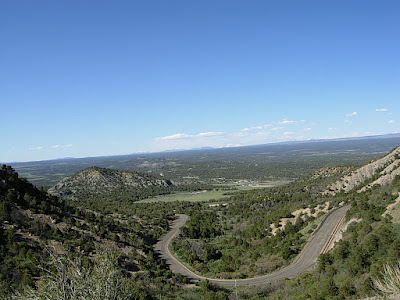Because of the incredible mountain scenery, the narrow gauge railroads were very popular for public excursions, and they still are. The train out of Chama was fully booked that morning, and we were part of a procession of cars full of railfans following it as it chugged out of town.
Leaving the station.
Just outside of town, the train passes by the famous "Jukes' Tree" first photographed by railfan Fred Jukes in 1908. (It's the pine on the left of the tracks with all of the missing branches.)
Trestle!
(It burned down a month later in a brush fire and had to be rebuilt.)
(It burned down a month later in a brush fire and had to be rebuilt.)
Lots of winding turns through the valleys to manage the elevation climb.
Coming around Windy Point (with the highway below).
At the top of Cumbres Pass.
Spring snow melt.
We chased the train a bit further, but the road and the tracks split a few miles on and don't meet up again until you get to Antonito, so we turned around and head back to Chama. From there, we headed west and then north on the road to Pagosa Springs, CO. The drive was full of stunning scenery.
One thing has struck me about Colorado is that no matter where I go in the state, there is remarkable sculptural art everywhere, even in the most mundane places, such as this mall parking lot in Pagosa Springs.
About 20 miles west of Pagosa Springs on the road to Durango is Chimney Rock National Monument, an ancient Ancestral Puebloan (Anasazi) site. Situated between two spires of rock on a cliff overlooking the valley, the site features more than 200 rooms, including pit houses and ceremonial kivas. Archaeologists think that as many as 2,000 people may have lived there from about A.D. 925 to 1125.
We continued on to Durango where we spent a few minutes driving around town. My parents were there in the 1970's and were curious to see how it had changed. While we were stopped in traffic, we spotted a mule deer casually strolling across a nearby construction site.
With my background in history and archaeology, one of the places I most wanted to visit on our trip was Mesa Verde, so we continued west from Durango into Anasazi country.
Nearly there!
The road into the park twists and winds its way up to the top of the mesa, affording some spectacular views.
Fires are a natural part of the ecology of the southwest, and the skeletons of dead trees bear witness to their passage through the park. The Bircher Fire in 2000 burned more than 23,000 acres.
The visitors' center.
The lobby.
A fabulous Navajo sand painting on display.
Pretty decor. (Yep, the Navajo storm patterned purse is of course mine.)
We opted to eat at the casual visitors' cafe (with gift shop) just down the road from the welcome center, and while driving we spotted some horses. We thought for sure they must be trail horses belonging to the park service, but the gal in the welcome center assured us they were in fact wild.
My first view of Mustangs!
Inside the cafe (apologies for the blurry shot).
The view from the dining room.
After dinner, we sat on the balcony behind our room to look out across the green table land for which the park was named. The utter quiet was marvelous, and it was a thrill to see the indigo-black sky full of stars for once.

































No comments:
Post a Comment